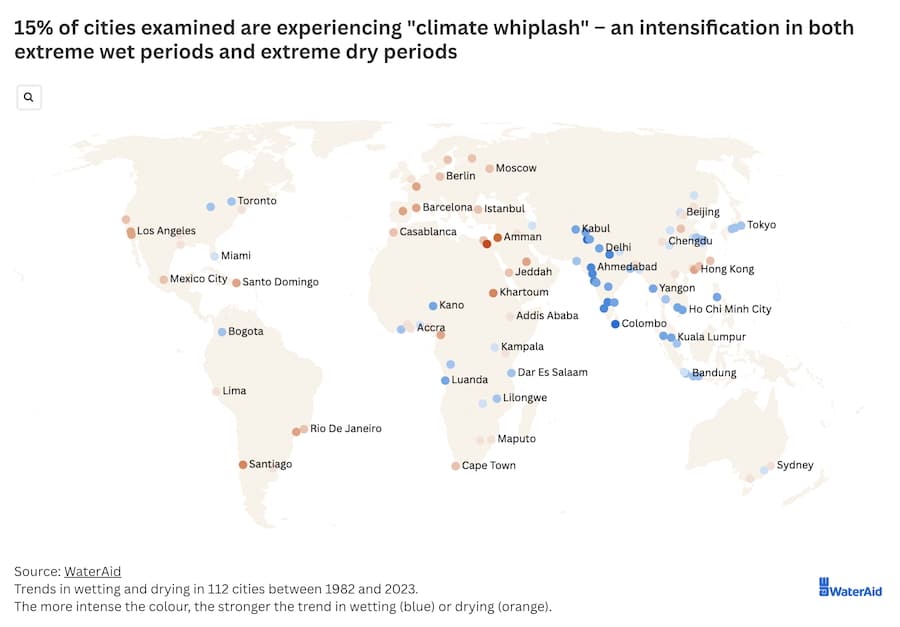This post was originally published on Eco Watch
In a new report, researchers have ranked global cities for flood and drought risks and determined that some of the biggest cities in the world are facing dangerous climate swings between dry and wet periods. Some cities have seen a total change in their climate, moving from typically dry regions to regions prone to flooding and vice versa, according to the study.
The report, conducted by non-governmental organization WaterAid in collaboration with researchers from the University of Bristol and Cardiff University, investigated the climate trends in the 100 most-populated cities globally as well as 12 cities where the NGO operates.
In total, 95% of the observed cities were experiencing a shift toward wetter or dryer climates, as The Guardian reported.
According to the findings, 15% of the cities are experiencing climate “whiplash,” where they face periods of drought almost immediately followed by flooding. As The Guardian reported, the recent wildfires in Los Angeles were an example of such whiplash, with wetter periods both before and after the fires.
The rainy period increased vegetation growth, which fueled larger fires. Now, after the fires, some people in Southern California are being evacuated amid wetter weather because of increased mudslide risks, ABC News reported.
“These are recent burn areas and are especially susceptible to heavy rain,” the Los Angeles Fire Department warned. These extreme back-and-forth patterns are happening to cities globally and could worsen, the new report warned.
About 20% of the cities in the study have shifted from more dry extreme weather to wet extremes, with 13% of these cities moving toward wetter climate extremes and 7% moving toward drier extremes.
“Places that were historically wet are becoming dry and vice versa. Other places are now increasingly battered by both extreme floods and droughts. A deeper understanding of localised climate hazards can support more intelligent and bespoke planning in major cities,” Katerina Michaelides, co-lead scientist on the project and professor of Dryland Hydrology at the University of Bristol, said in a statement.
The cities facing varying climate extremes face risk of infrastructure that cannot keep up with the shifts in wet or dry weather events. As explained by WaterAid, extreme flooding threatens water sanitation and waste systems, which can lead to disease spread. On the other hand, extreme drought puts strain on water resources.
South and southeast Asia and north and east Africa were highlighted as two particularly vulnerable regions to the extreme climate whiplash, with the cities facing the highest risks including Khartoum, Sudan; Faisalabad, Pakistan; Lahore, Pakistan; Baghdad, Iraq; Surabaya, Indonesia; Nairobi, Kenya; and Addis Ababa, Ethiopia.
“As the nature and intensity of natural hazards change, their impacts on urban communities will be significantly shaped by social and infrastructural vulnerabilities,” said Sean Fox, associate professor of global development at University of Bristol who provided research for the report. “In other words, risk isn’t just about the chance of a flood or drought occurring, it’s also about how prepared communities are to deal with these hazards.”
To improve equitable access to water, sanitation and hygiene services and make infrastructure better prepared for changing climate and extreme weather, WaterAid is recommending for governments to prioritize climate and water actions and provide plans for adapting to climate; for developers, banks and the private sector to increase investments in climate-resilient water infrastructure and services; and for all parties involved in water services and infrastructure to prioritize the most vulnerable communities.
“We urge the UK to show leadership and maintain its influential role in tackling global climate and health challenges — essential to creating a secure world free from poverty,” Tim Wainwright, chief executive of WaterAid UK, said in a statement. “Now, we need to turn commitments into action — for leaders to build and invest in systems worldwide that can withstand extreme weather and keep clean water flowing globally.”
The post Dangerous Climate ‘Whiplash’ Is Impacting Cities Globally, Report Finds appeared first on EcoWatch.





0 Comments